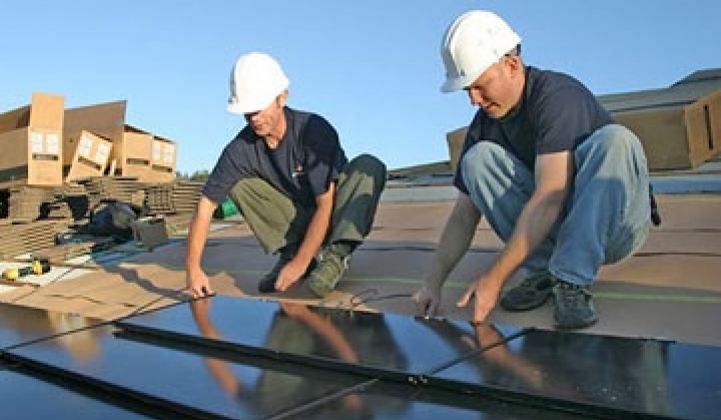The number of solar energy installations in California shot up nearly three-fold during the first four months of this year, state data shows. Government agencies, in particular, are leading the way on installations.
Solar service companies installed nearly 90 megawatts of solar power systems for from January through April this year, compared with 33.4 megawatts for the same period in 2008, according to the California Solar Initiative (CSI). The CSI is a rebate program that is available to customers of the three largest investor-owned utilities: Pacific Gas and Electric, Southern California Edison and San Diego Electric & Gas.
Residential installation grew 58 percent for the first four months to reach 19.3 megawatts for the first four months of this year from 12.2 megawatts a year ago, while installations on commercial, government and nonprofit properties tripled to 70.6 megawatts from 21.2 megawatts.
A change in federal law that went into effect in January and allows homeowners to claim a 30 percent investment tax credit has made a difference, said Daniel Englander, a senior energy analyst at GTM Research.
Englander noted that the big boost in the amount installed most likely came from applications filed in late 2008, however. The new residential applications filed in the first four months of this year in fact declined 14.1 megawatts from 20.5 megawatts in the last four months of 2008. The fact that rebates for PG&E customers were set to become lower in December also contributed to the spike in applications.
The non-residential applications have shot up from 31.4 megawatts in the last fourth months of 2008 to 52.6 megawatts in the first four months of 2009, the CSI data showed. During the first four months of 2008, the CSI received 29.3 megawatts worth of applications.
The non-residential sector has historically been larger than the residential one because the sizes of solar energy systems that go on top of warehouses, schools and others tend to be larger. Anticipating that rebates for non-residential customers would become lower in February, applications for that month reached 22.8 megawatts, the most of any month since the CSI's launch in 2007.
Mark Bachman, a senior equity analyst at the Pacific Crest Securities sees more value in examining the data for new applications rather than the amount installed. He said application data provide a better indication of current and future market trends.
A recent analysis of the non-residential applications showed that government customers are driving the growth, Bachman said. He culled information from the raw data in the CSI database but used the power generation capacities listed by the solar panel manufacturers (expressed in direct current).
The CSI uses a different metrics that looks at the power output of a solar energy system in alternating current (AC) and takes into account real-world conditions such as shading. As a result, the generation capacities presented by the CSI are typically lower than what the manufacturers claim.
Government applications for the first four months of this year jumped to 33.1 megawatts, or 153 percent, from the same period a year ago, Bachman said. Commercial applications rose 22 percent to 21.9 megawatts while residential applications increased 8 percent to 16.4 megawatts. The nonprofit sector jumped 242 percent; but at 6.8 megawatts, it's the smallest slice of the pie.
Overall, the applications for all the market segments grew 59 percent, Bachman said.
"It's easier for the government to finance a project than for a residential or commercial customer," Bachman said. "With governments, they are going to pay the bills. There is a lot more certainty."
The federal stimulus plan has set aside $5.5 billion to make federal buildings more energy efficient, and that could include installing solar energy systems. The plan also is creating a grant program to boost other types of solar installations. But the government is still drafting rules for how to dole out these funds, which are expected to become available until the second half of this year.
The applications also showed that solar panel makers Sharp and SolarWorld are gaining new converts fast. Sharp occupied 16.9 megawatts worth of applications for both residential and non-residential types from January through April this year, a 176 percent jump from the same period a year ago, Bachman said. SolarWorld followed with 15.6 megawatts, or a 235 percent hike, and SunPower with 13.9 megawatts, or a 14 percent gain.
Suntech Power's name might appear only on 9.1 megawatts worth of applications for the first four months of 2009, but that quadrupled what the company had a year ago, Bachman noted.
Join industry leaders and influencers at Greentech Media's Concentrating Solar Technologies & Markets at Intersolar in Munich, Germany on May 29.




